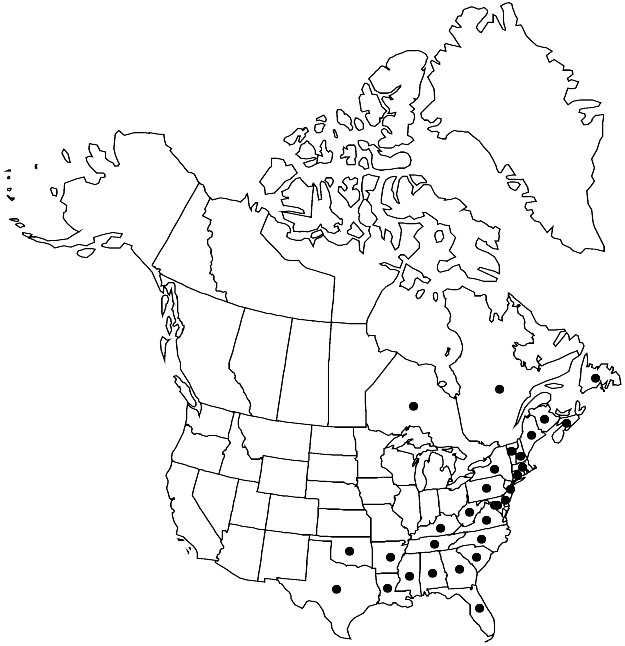Fontinalis novae-angliae
Musc. Hepat. U.S., 104. 1856.
Plants to 40 cm, green, yellowish, reddish, or brownish. Stems medium to robust, rigid; stem and branch apices swollen and loosely foliate, sometimes tightly short-attenuate; axillary hairs 500–650 µm, 5–8 cells, basal cell quadrate, red, distal cells long-cylindric, hyaline or reddish. Leaves monomorphic, erect to imbricate when dry or moist, firm, ovate, ovate-lanceolate, or oblong-lanceolate, concave to tubular-concave, 2.5–5.5 mm; margins erect or plane at base, erect to incurved at apex; apex acute to subtruncate; medial laminal cells linear-fusiform, 80–180 × 8–15 µm. Perigonia with leaves 1–1.2 mm. Perichaetia with leaves oval to suborbiculate, 2.4–2.8 mm, apex obtuse. Seta 0.1–0.3 mm. Capsule immersed to slightly emergent, subcylindric to cylindric, 1.5–2.5 mm; operculum obtuse-conic, 1 mm; endostome trellis imperfect to subperfect. Calyptra 1.2–1.5 mm. Spores 12–18 µm.
Habitat: Rock, boulders, roots in ponds, lakes, streams, rivers, summer dry streams
Elevation: low to moderate elevations (0-600 m)
Distribution

N.B., Nfld. and Labr. (Nfld.), N.S., Ont., Que., Ala., Ark., Conn., Del., D.C., Fla., Ga., Ky., La., Maine, Md., Mass., Miss., N.H., N.J., N.Y., N.C., Okla., Pa., S.C., Tenn., Tex., Vt., Va., W.Va.
Discussion
Dry plants of Fontinalis novae-angliae have concave leaves, but plants from fast moving streams sometimes have flat leaves with narrowly reflexed margins when dry. There are two distinct expressions of F. novae-angliae. The typical expression has somewhat lax plants with well-spaced, broad, moderately concave leaves. In the cymbifolium expression the plants are stiff with closely spaced, narrow, tubular-concave leaves. Fontinalis howellii is the only other species in the genus with tubular-concave leaves; however, its stem leaves are keeled-conduplicate.
Fontinalis novae-angliae has been confused with F. sphagnifolia, which differs in having long, tightly attenuate stem and branch apices. Fontinalis dalecarlica and F. novae-angliae have often been confused because both have firm, concave leaves. But F. dalecarlica is a slender species with narrow leaves (stem leaves 0.5–1.2 versus 0.7–2 mm wide) that usually have plane apical leaf margins when moist and reflexed proximal leaf margins when dry.
Selected References
None.